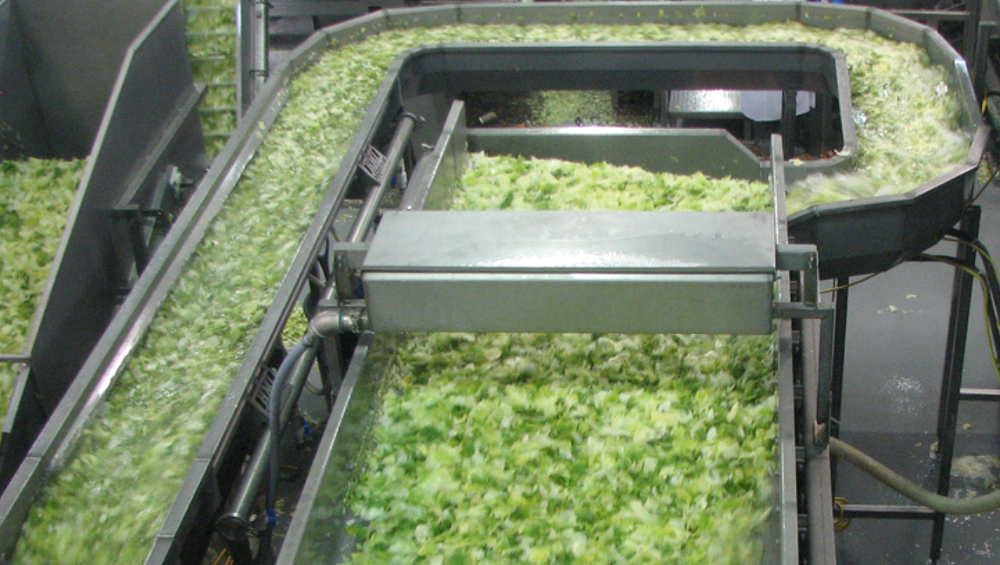See clarification note at bottom
Today the FDA released findings of a special testing program spurred by the deadly 2018 E. coli outbreak linked to romaine lettuce. It shows somewhat similar results as the outbreak investigation did, including a seeming lack of attention to the processing plants that chop and package bagged leafy greens in the area associated with the outbreak.
The FDA didn’t find the outbreak strain of the pathogen that sickened people in the largest E. coli O157 outbreak since 2006 when it did spot checks in romaine lettuce fields and cooling facilities, but it did not check for the bacteria when it visited one of many chopping plants that commingled the lettuce from multiple farms.
Experts have said for years that bagged lettuce and other greens, especially when pre-chopped, are a frequent source of foodborne pathogens and illnesses.

But, the Food and Drug Administration “sampling assignment” that was associated with the 2018 outbreak that killed five people and sickened at least 210 across 27 states did not focus on processing facilities.
“During the assignment, the FDA collected and tested 118 samples for each pathogen. The FDA did not detect Salmonella in any of the samples. The agency detected Shiga toxin-producing E.coli (STEC) in a single sample, however, further analysis determined that the bacteria was not pathogenic,” according to today’s announcement.
“The findings of this assignment suggest that there was no widespread STEC or Salmonella spp. contamination of romaine lettuce from the Yuma growing region during the period when the sampling occurred. The FDA is continuing to work with leafy greens stakeholders in the Yuma region to consider a longer-term environmental study to identify and control risks that will prevent future outbreaks, with the ultimate goal of protecting consumers.”
The agency’s investigation report says it only interviewed processors during the “environmental assessment” part of the outbreak investigation. Environmental assessment includes equipment, outdoor elements, and facilities that cool whole heads of romaine immediately after harvest. The FDA did not mention any testing of equipment or other surfaces in the chopping plants.
“FDA was not able to conduct regulatory inspections and observe the manufacturing/processing of leafy greens at all fresh-cut produce manufacturing/processing facilities identified in the traceback investigation because many of these facilities were not in operation due to the end of the growing season and the manufacturing/processing equipment that may have been used was no longer available for inspection,” according to the report.
“No deficiencies were found in the single facility which was visited.”
However, the FDA report does say “low-level E. coli O157:H7 contamination of the romaine lettuce from some of the growing fields identified in the traceback could have been amplified by commingling cut romaine lettuce in wash systems at fresh-cut produce manufacturing/processing facilities.
The report makes an even stronger statement about the impact of commingling leafy greens at processing plants. The report provides details on how the traceback investigation identified a total of 36 fields on 23 farms in the Yuma growing region as supplying romaine lettuce that was potentially contaminated and consumed during the outbreak.
“The EA team made several visits to the Yuma growing region to conduct its work. During these visits, the team collected numerous environmental samples. Three of these samples were found to contain E. coli O157:H7 with the same rare genetic fingerprint (by whole genome sequencing) as that which made people sick,” according to the report.
“These three samples were collected in early June from a 3.5 mile stretch of an irrigation canal near Wellton in Yuma County that delivers water to farms in the local area, including several identified in the traceback as having potentially shipped romaine lettuce contaminated with the outbreak strain.
“This strain of E. coli O157:H7 was not detected in any other samples collected during this EA, although other human pathogens were found in these samples. Because the Yuma region’s growing season had concluded weeks before the EA started, no leafy greens were available for sampling and testing by the EA team.”
Summary and recommendations
In addition to urging consumers to wash leafy greens at home, the agency posted a list of bullet points, on its observations and recommendations.
Summary
FDA has identified the following factors and findings as those that most likely contributed to the contamination of romaine lettuce from the Yuma growing region with E. coli O157:H7 that caused this outbreak.
Growing Environment:
- The outbreak strain of E. coli O157:H7 was found in water from three locations along a 3.5 mile stretch in an irrigation canal near Wellton in Yuma County, Arizona.
- The outbreak strain was not found anywhere else in sampling done during the EA in the Yuma growing region of Imperial County, California, and Yuma County, Arizona, although other human pathogens were identified in collected samples.
-

Much of the romaine lettuce grown in the Yuma, AZ, area comes from fields adjacent to or very near feedlots. These fields were still flush with fresh produce before and during the 2018 outbreak. Many growers irrigate leafy greens and other produce in the area with water from some of the hundreds of miles of open canals, some of which run alongside animal feeding operations such as the one shown in the background here. FDA has concluded that the water from the irrigation canal where the outbreak strain was found most likely led to contamination of the romaine lettuce consumed during this outbreak.
- FDA cannot rule out that other sources or means of romaine lettuce contamination with the outbreak strain of E. coli O157:H7 may have occurred.
- There are several ways that irrigation canal water may have come in contact with the implicated romaine lettuce including direct application to the crop and/or use of irrigation canal water to dilute crop protection chemicals applied to the lettuce crop, either through aerial or ground-based spray applications.
- How and when the irrigation canal became contaminated with the outbreak strain is unknown. A large animal feeding operation is nearby but no obvious route for contamination from this facility to the irrigation canal was identified. Other explanations are possible although the EA team found no evidence to support them.
Recommendations for prevention:
This is the largest STEC outbreak in the United States in over a decade. It has had serious public health consequences as well as ramifications for the produce industry. Leafy greens are a common item in the diet for many Americans and there can be several steps along the supply chain between the farm and the consumer. Measures to prevent contamination are critical along each of these steps.
 Therefore, all segments of the leafy greens industry should thoroughly review current operations, procedures, policies and practices taking into consideration the findings of this EA, the FSMA Produce Safety Rule, the FSMA Preventive Controls for Human Foods Rule and other relevant FSMA regulations. Other available science-based information relevant to the reduction or elimination of human pathogens on leafy greens should also be considered. Necessary modifications should be made to operations, procedures, policies and practices to ensure safe products for consumers and minimize the likelihood of similar outbreaks in the future.
Therefore, all segments of the leafy greens industry should thoroughly review current operations, procedures, policies and practices taking into consideration the findings of this EA, the FSMA Produce Safety Rule, the FSMA Preventive Controls for Human Foods Rule and other relevant FSMA regulations. Other available science-based information relevant to the reduction or elimination of human pathogens on leafy greens should also be considered. Necessary modifications should be made to operations, procedures, policies and practices to ensure safe products for consumers and minimize the likelihood of similar outbreaks in the future.
Outbreaks involving leafy greens can be challenging to investigate because of the short shelf-life of the product, the wide distribution and consumption of leafy greens and the complex supply chain between the farm and the end user. These factors demonstrate the importance of implementation of the FSMA Produce Safety Rule provisions and GAPs on farms as well as the FSMA Preventive Controls for Human Foods Rule provisions, in manufacturing/processing facilities and throughout the supply chain. These provisions are designed to prevent food contamination, foodborne illness, and foodborne outbreaks rather than reacting to them once they’ve occurred.
FDA recommends that growers and processors of leafy greens:
- assure that all agricultural water (water that directly contacts the harvestable portion of the crop) used by growers is safe and adequate for its intended use (including agricultural water used for application of crop protection chemicals);
- assess and mitigate risks related to land uses near or adjacent to growing fields that may contaminate agricultural water or leafy greens crops directly (e.g. nearby cattle operations or dairy farms, manure or composting facility);
- verify that food safety procedures, policies and practices, including supplier controls for fresh-cut processors, are developed and consistently implemented on farms (both domestic and foreign) and in fresh-cut produce manufacturing/processing food facilities to minimize the potential for contamination and/or spread of human pathogens;
- when a foodborne pathogen is identified in the growing or processing environment, in agricultural inputs (e.g., agricultural water), in raw agricultural commodities or in fresh-cut ready-to-eat produce, a root cause analysis should be performed to determine the likely source of the contamination, if prevention measures have failed, and whether additional measures are needed to prevent a reoccurrence; and
- Local in-depth knowledge and actions are critical in helping resolve potential routes of contamination of leafy greens in the Yuma growing region, including Imperial County and Yuma County moving forward. FDA urges other government and non-government entities, produce growers and trade associations in Yuma and Imperial Counties to further explore possible source(s) and route(s) of contamination associated with the outbreak pathogen and with other foodborne pathogens of public health significance. This information is critical to developing and implementing short- and long-term remediation measures to reduce the potential for another outbreak associated with leafy greens or other fresh produce commodities.
Clarification: The original version of this story did not make clear that today’s announcement was in regard to only the special “sampling assessment” and not the main investigation of the outbreak.
(To sign up for a free subscription to Food Safety News, click here.)

